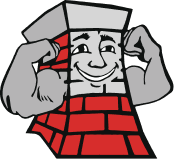Has My Chimney Had a Fire? Here’s How to Tell
 Homeowners we work with are often surprised to find out that their chimney had a fire that they didn’t know about. Explosive chimney fires that sound like a train is rushing through your living room and have shooting flames that can be seen by your neighbors do happen, but they are rare. Most chimney fires are quiet and slow burning. The only sign is the damage left behind.
Homeowners we work with are often surprised to find out that their chimney had a fire that they didn’t know about. Explosive chimney fires that sound like a train is rushing through your living room and have shooting flames that can be seen by your neighbors do happen, but they are rare. Most chimney fires are quiet and slow burning. The only sign is the damage left behind.
Quiet, slow-burning chimney fires are usually caused by either a stray spark or high temperatures that ignite creosote buildup in the chimney. Creosote is a highly combustible substance that often looks sticky and tar-like. It is produced by burning wood. If there is a large amount of creosote, it can burn for a long period of time and reach extremely high temperatures that can cause severe damage to the chimney system and to your home. The damage can include:
- Cracked or collapsed tile flue lining
- Warped or damaged metal flue lining
- Melted mortar
- Melted or damaged roofing
- Heat damage to ceilings, walls, or structural beams near the chimney
The most dangerous consequence of a chimney fire is that it creates pathways for carbon monoxide to enter your home and destroys the defenses that protect against a future house fire. If the damage is not repaired, a stray spark or second chimney fire could easily escalate to a house fire. Using a fireplace with a warped metal flue lining or cracked tile flue lining could also result in carbon monoxide poisoning.
Due to the high risks, it is important to have your chimney inspected by a CSIA certified chimney specialist at least once a year and pay attention for signs that your home might have had a chimney fire. In the 11 months between inspections a lot can happen. If you aren’t on the lookout for warning signs, you could unknowingly put your home and family at risk. That is why the Chimney Safety Institute of America (CSIA) compiled the following list of 9 indicators of a chimney fire that homeowners can spot.
Signs You Had a Chimney Fire
• Shards or flakes of creosote on the ground, around the roof or in the firebox
• Pieces of creosote that look puffy or like honey comb
• Broken or cracked pieces of flue tiles
• Damaged or melted roofing material
• A discolored or disfigured chimney cap/rain cap or chase cover
• Cracks in the masonry on the outside of the chimney
• Heat damage to a TV antenna or dish
• Warped metal components like a metal damper, smoke chamber connection pipe, flue liner, or factory-built chimney
 If you notice any of these indicators, you should reach out to a certified chimney specialist to have your chimney professionally inspected. A CSIA certified technician, like ours, will use special equipment to get a close look at your chimney to determine the extent of the damage and let you know the best course of action for repairs.
If you notice any of these indicators, you should reach out to a certified chimney specialist to have your chimney professionally inspected. A CSIA certified technician, like ours, will use special equipment to get a close look at your chimney to determine the extent of the damage and let you know the best course of action for repairs.
Even though the risks are severe, be sure that you only trust the word of a reliable, CSIA certified chimney professional. Unfortunately, there are many scam artists who have taken advantage of homeowner’s fears about the risks of a chimney fire. Check the CSIA website to make sure that the chimney technician you hire is certified and do not agree to repairs without seeing a detailed report that includes photographic or video evidence of the damage.
You can always count on a high level of professionalism and customer care from our CSIA certified team. If you live in Central Connecticut and think your home has had a chimney fire, give us a call at 860-233-5770. We are here to serve you!


